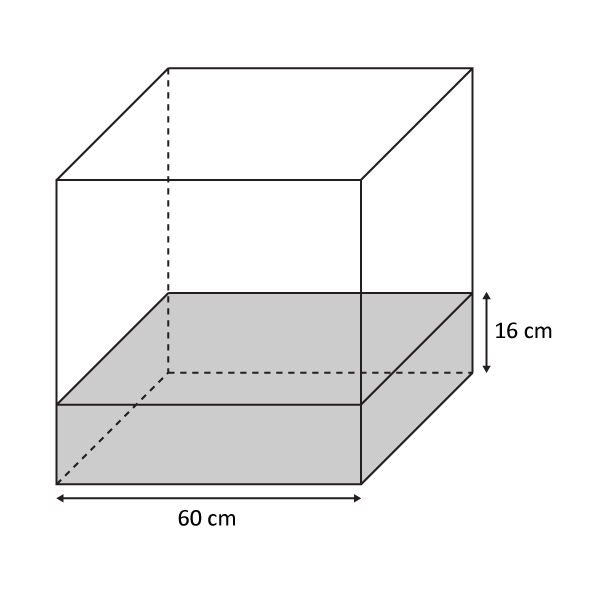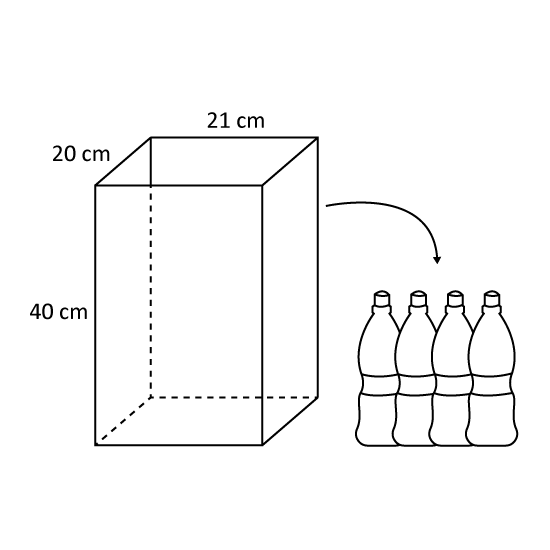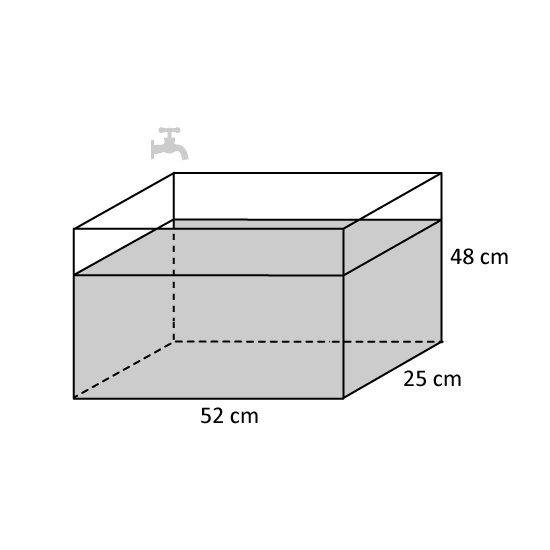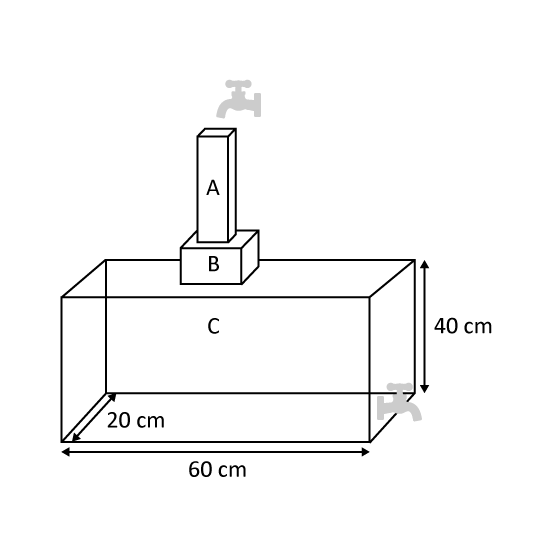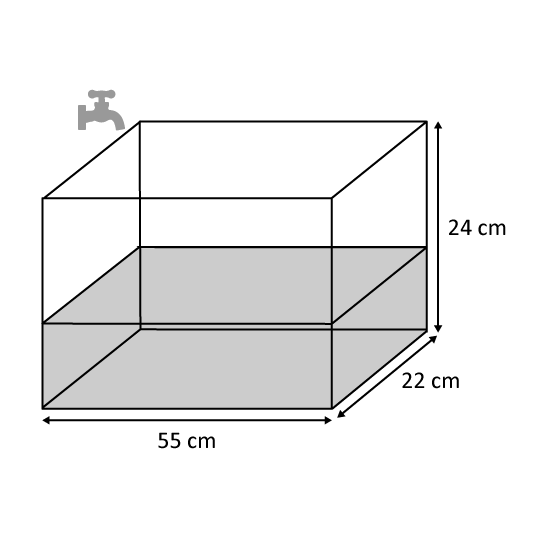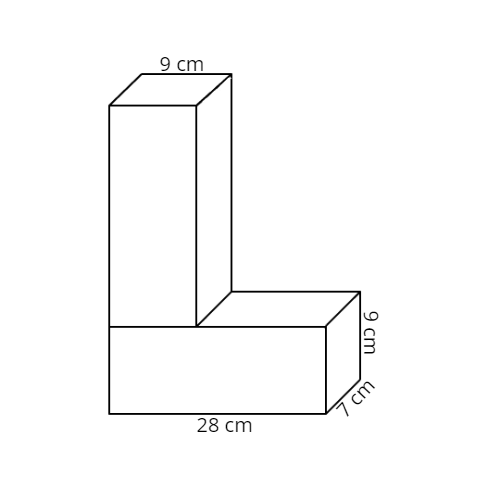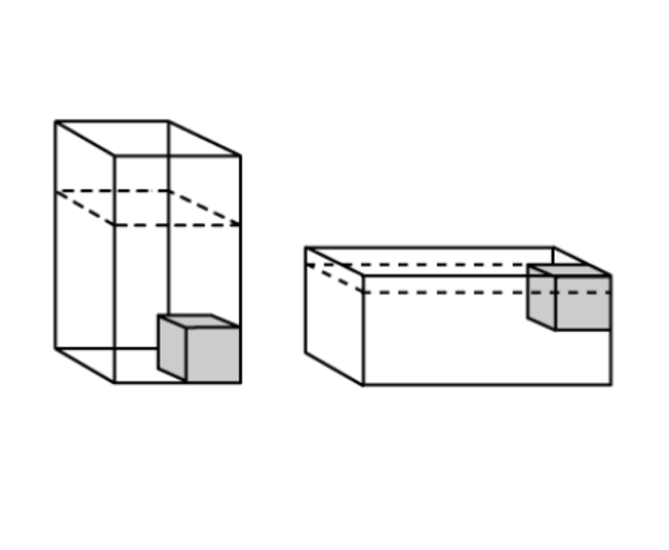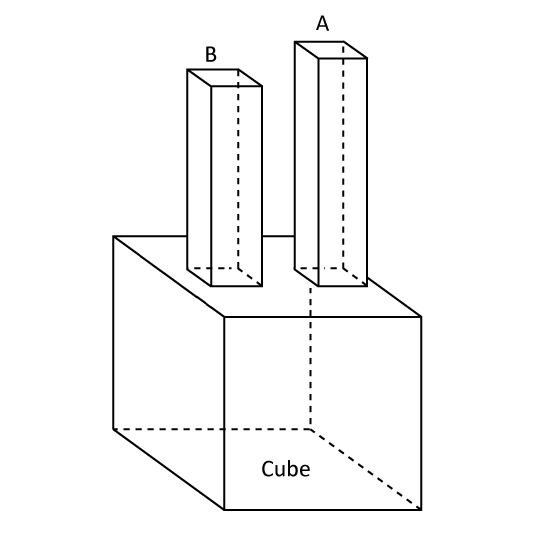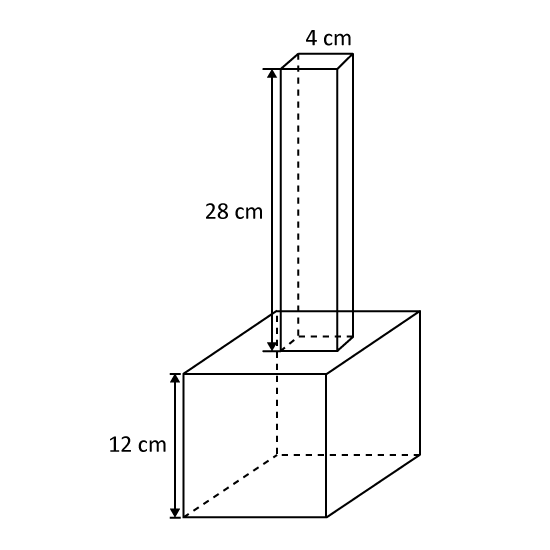Level 2
A cubical container is filled with water to a height of 16 cm as shown. How much more water is needed to fill the container to the brim? Express your answer in litres.
Level 2
A cubical container is filled with water to a height of 16 cm as shown. How much more water is needed to fill the container to the brim? Express your answer in litres.
Image in this question is not available.
Level 2
A minute ago, a fish tank with a base area of 400 cm2 contained water to a depth of 9 cm. I poured in another 560 cm3 of water into the tank. What is the height of the water in the tank now?
2 m
Image in this question is not available.
Level 2
A cylindrical container is filled with 68.02 ℓ of water. It was then poured into an empty rectangular fish tank measuring 80 cm by 0.5 m by 28 cm until it is 47 full. How much water is left in the cylindrical container? Leave your answer in ℓ and mℓ.
2 m
Image in this question is not available.
Level 2
A rectangular container measuring 20 cm by 40 cm by 15 cm is 25 filled with water. Tom wants to fill up the container completely with some bottles of water. How many bottles of water are needed if the capacity of each bottle is 900 mℓ?
2 m
Image in this question is not available.
Level 2 The tank, measuring 21 cm by 20 cm by 40 cm, is
34 filled with water at first. All the water is poured into empty identical bottles to the brim. Each bottle has a capacity of 700 mℓ.
- How much water was there in the tank at first? Give your answer in millilitres.
- How many such bottles are completely filled with water?
Level 2 The tank, measuring 21 cm by 20 cm by 40 cm, is
34 filled with water at first. All the water is poured into empty identical bottles to the brim. Each bottle has a capacity of 700 mℓ.
- How much water was there in the tank at first? Give your answer in millilitres.
- How many such bottles are completely filled with water?
Image in this question is not available.
Level 3
In the figure, a fish tank measuring 52 cm by 25 cm by 48 cm contained 2720 mℓ of water. Serene then turned on a tap that flows at a rate of 4.32 ℓ per minute. How long does it take for the tank to be 23 filled with water? Express your answer in min.
Level 3
In the figure, a fish tank measuring 52 cm by 25 cm by 48 cm contained 2720 mℓ of water. Serene then turned on a tap that flows at a rate of 4.32 ℓ per minute. How long does it take for the tank to be 23 filled with water? Express your answer in min.
Image in this question is not available.
Level 3
A rectangular tank measuring 50 cm by 25 cm by 19 cm was 12 filled with water. There was a leak at the bottom of the tank and water seeped out at the rate of 5 m? per second. How many minutes would it take to empty the tank completely? Leave your answer correct to 1 decimal place.
3 m
Image in this question is not available.
Level 3
An empty tank measures 50 cm by 20 cm by 35 cm. Water flows into the tank from Tap A at a rate of 25 ℓ per minute. At the same time, water drains from the tank from Tap B at a rate of 18 ℓ per minute. How long would it take to completely fill the tank?
Level 3
An empty tank measures 50 cm by 20 cm by 35 cm. Water flows into the tank from Tap A at a rate of 25 ℓ per minute. At the same time, water drains from the tank from Tap B at a rate of 18 ℓ per minute. How long would it take to completely fill the tank?
Image in this question is not available.
Level 3
A tank measuring 30 cm by 24 cm by 20 cm was being filled by two taps. Tap X delivered water at a rate of 140 cm3 per minute while Tap Y delivered water at a rate of 100 cm3 per minute. How long did the 2 taps take to fill the tank completely? Express your answer in min.
3 m
Image in this question is not available.
Level 3
The figure shows a tank made up of 3 sections. Cuboid A with a square base of side 4 cm and height 30 cm. Cube B with a side of 12 cm. Cuboid C that is 60 cm by 20 cm by 40 cm. Water from a tap above flows down at a rate of 1.2 litres per minute while water is drained out from the bottom at a rate of 1 litre per minute. How long did it take to fill up the tank to a height of 66 cm from the base? Give the answer in minutes correct to nearest whole number.
Level 3
The figure shows a tank made up of 3 sections. Cuboid A with a square base of side 4 cm and height 30 cm. Cube B with a side of 12 cm. Cuboid C that is 60 cm by 20 cm by 40 cm. Water from a tap above flows down at a rate of 1.2 litres per minute while water is drained out from the bottom at a rate of 1 litre per minute. How long did it take to fill up the tank to a height of 66 cm from the base? Give the answer in minutes correct to nearest whole number.
Image in this question is not available.
Level 3
The figure shows a rectangular tank measuring 55 cm by 22 cm by 24 cm. It was 13 filled with water at first. Dylan turned on a tap and let water flow into the tank at a rate of 1.36ℓ per minute. After 15 minutes, he turned off the tap. How much water had overflowed? (Express the answer in ℓ.)
Level 3
The figure shows a rectangular tank measuring 55 cm by 22 cm by 24 cm. It was 13 filled with water at first. Dylan turned on a tap and let water flow into the tank at a rate of 1.36ℓ per minute. After 15 minutes, he turned off the tap. How much water had overflowed? (Express the answer in ℓ.)
Image in this question is not available.
Level 3
Shemy placed three empty tanks side by side. The smallest tank has a crack at its side and the base area of each tank is 16 cm2. After she turned on the tap for 64 minutes, the height of the water in the smallest tank became 6 cm although 0.5 mℓ of water is leaking out of the crack per minute. Find the rate of flow of water from the tap. Give the answer in mℓ/min.
Level 3
Shemy placed three empty tanks side by side. The smallest tank has a crack at its side and the base area of each tank is 16 cm2. After she turned on the tap for 64 minutes, the height of the water in the smallest tank became 6 cm although 0.5 mℓ of water is leaking out of the crack per minute. Find the rate of flow of water from the tap. Give the answer in mℓ/min.
Image in this question is not available.
Level 3 Oscar had two identical wooden cuboid measuring 28 cm by 7 cm by 9 cm. He glued them together to form a solid as shown. He then painted the whole solid in white paint. After that, he cut the solid into 1-cm cubes.
- How many 1-cm cubes did he get?
- How many 1-cm cubes had none of its faces painted white?
Level 3 Oscar had two identical wooden cuboid measuring 28 cm by 7 cm by 9 cm. He glued them together to form a solid as shown. He then painted the whole solid in white paint. After that, he cut the solid into 1-cm cubes.
- How many 1-cm cubes did he get?
- How many 1-cm cubes had none of its faces painted white?
Image in this question is not available.
Level 2
A container, which is 10 cm long, 9 cm wide and 7.55 cm deep, holds 1510 g of sugar. If 4.95 kg of the same sugar is packed into a tin with a 15-cm square base, how tall must the tin be?
3 m
Image in this question is not available.
Level 3
Figure 1 shows a closed rectangular tank of dimensions 40 cm by 40 cm by 80 cm with a cube of edge 20 cm glued to its bottom left corner. The tank contains 70 litres of water. Figure 2 shows the same rectangular tank lying on its side. Find the height of the water level, in centimetres, corrected to 2 decimal places.
Level 3
Figure 1 shows a closed rectangular tank of dimensions 40 cm by 40 cm by 80 cm with a cube of edge 20 cm glued to its bottom left corner. The tank contains 70 litres of water. Figure 2 shows the same rectangular tank lying on its side. Find the height of the water level, in centimetres, corrected to 2 decimal places.
Image in this question is not available.
Level 3
The figure shows an empty transparent tank made from three containers. The two containers A and B on top are in the form of cuboids which have square bases of side 6 cm and 4 cm as shown in the figure. The bottom container is in the form of a cube of side 14 cm. 3.42ℓ of water are poured into the empty vase. Find the height of the water level from the base of the vase.
(1 litre = 1000 cm3)
Level 3
The figure shows an empty transparent tank made from three containers. The two containers A and B on top are in the form of cuboids which have square bases of side 6 cm and 4 cm as shown in the figure. The bottom container is in the form of a cube of side 14 cm. 3.42ℓ of water are poured into the empty vase. Find the height of the water level from the base of the vase.
(1 litre = 1000 cm3)
Image in this question is not available.
Level 3
The figure shows a rectangular tank measuring 30 cm by 15 cm by 20 cm. Vera poured 558 mℓ of water into the tank. Then she turned on two taps at the same time to fill up Tank with water. Water was flowing from both taps at the same rate. After 5 minutes, both taps were turned off but 1.2ℓ of water had overflowed and was collected in a tray. Find the rate of the flow of water of each tap in millimetres per minute.
Level 3
The figure shows a rectangular tank measuring 30 cm by 15 cm by 20 cm. Vera poured 558 mℓ of water into the tank. Then she turned on two taps at the same time to fill up Tank with water. Water was flowing from both taps at the same rate. After 5 minutes, both taps were turned off but 1.2ℓ of water had overflowed and was collected in a tray. Find the rate of the flow of water of each tap in millimetres per minute.
Image in this question is not available.
Level 3 PSLE
The figure shows an empty flower vase of height 40 cm. It is made from 2 containers. The top container is in the form of a cuboid which has a square base side 4 cm and height 28 cm. The bottom container is in the form of a cube of 12 cm. 2.16 litres of water is poured into the empty vase. What is the height of the water level from the base of the vase?
(1 litre = 1000 cm3 )
Level 3 PSLE
The figure shows an empty flower vase of height 40 cm. It is made from 2 containers. The top container is in the form of a cuboid which has a square base side 4 cm and height 28 cm. The bottom container is in the form of a cube of 12 cm. 2.16 litres of water is poured into the empty vase. What is the height of the water level from the base of the vase?
(1 litre = 1000 cm3 )
Image in this question is not available.
Level 3
A rectangular tank measuring 60 cm by 50 cm by 25 cm was to be filled with water by two taps, A and B. Tap A which fills the tank at a rate of 8ℓ per minute was first turned on for 5 minutes before Tap B was turned on as well. If the tank was filled to the brim in a total of 7 minutes from the time when Tap A was first turned on, what is the rate at which Tap B fills the tank? Give the answer in ℓ per minute correct to 1 decimal place.
3 m
Image in this question is not available.
Level 3
Tank A, measuring 40 cm by 30 cm by 50 cm, was filled with water to the brim. Water was then poured from Tank A to Tank B, which has a base area of 900 cm2 until the height of the water level in Tank B became twice that of the water level in Tank A. Find the volume of water in Tank B, leaving the answer in litres.
3 m
Image in this question is not available.
